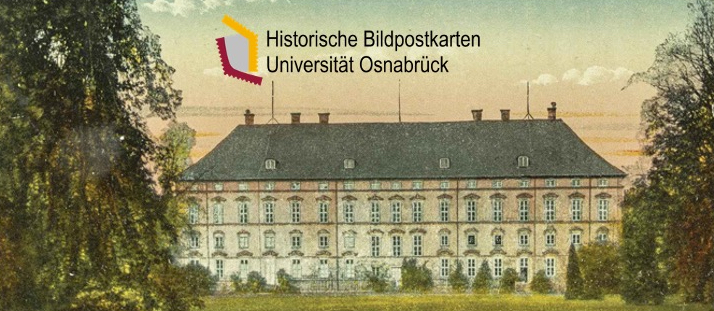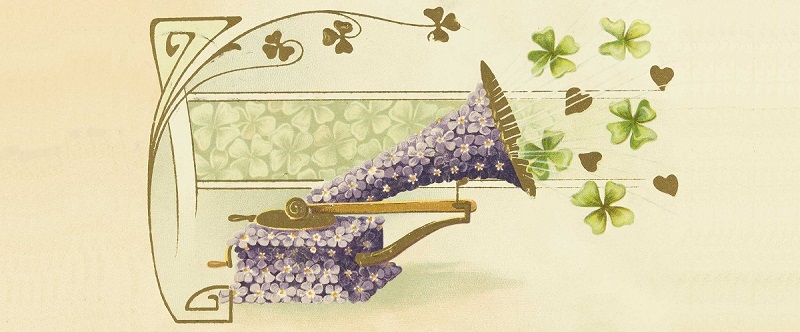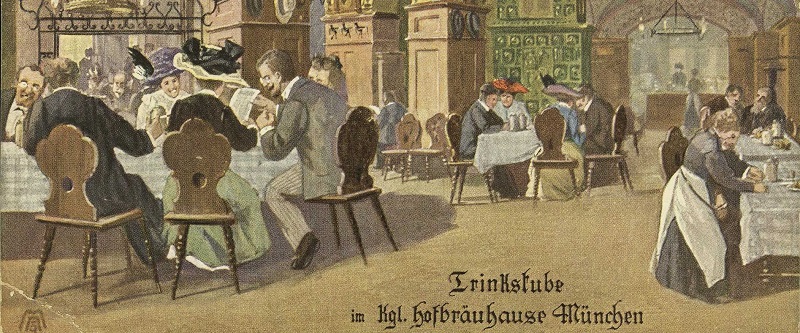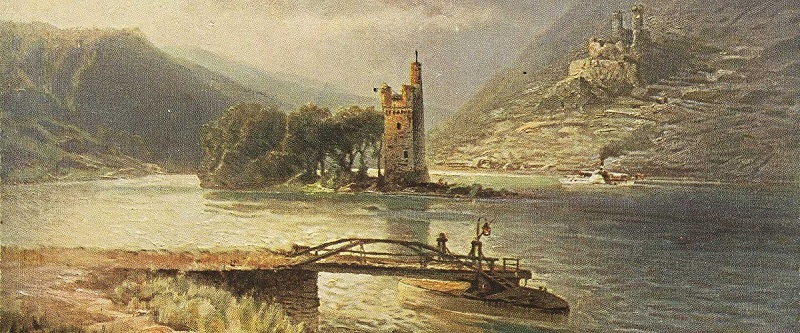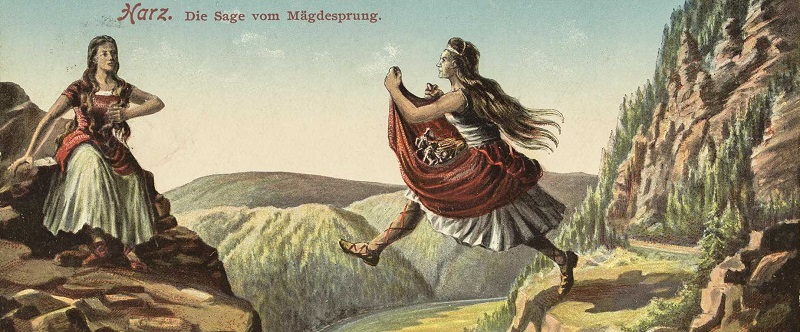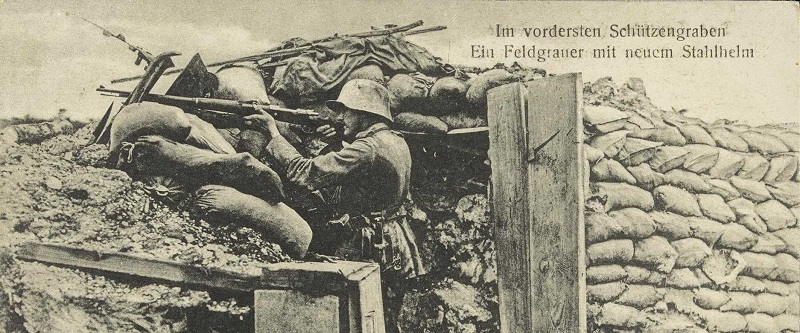Collection Description
The focus of our collection is on motif postcards from the beginnings of postcard making to the middle of the 20th century. Important thematic focuses are cards with a connection to music, cards on the First and Second World Wars as well as cards with images of women and men. We collect topographical postcards, i.e. the classic picture postcards, especially if they are part of a closed correspondence or a historical collection. For example, we have a set of historical albums created by young women during the First World War, in which they collected the news of their husbands, fathers and relatives from the front. Another set of albums includes the cards of the women in one family from the beginning of the 20th century until the 1970s.
Although our holdings are fully digitised, not all collections and postcards are freely accessible on the internet – partly for legal reasons, but also because they have not yet been catalogued. To offer you an overview of our collection, we present our holdings below:
Collection Prof. Dr. Sabine Giesbrecht
- Seperate volumes of the Giesbrecht Collection
- Collection Heinz Andrejewski
- Collection Anon. 1
- Collection Frans Bork
- Collection Anna Dietrich
- Collection Gisela Hassmann-Kube – Gustav Eichler
- Collection Prof. Dr. Johannes Kohstall
- Collection Christoph Müller-Oberhäuser
- Collection Günter Sonne
- World War album Gretchen Gröttrup
- World War album Marie R.
- World War album Johanna Storm
- World War Cards Warner Family
Special collections (parst of various collections)
Collection Prof. Dr. Sabine Giesbrecht ⇒
Main focus of the collection: music-related images (song postcards, portraits and images of musicians, musical instruments, venues, dance, music in social context, etc.), propaganda, advertising, gender, local history of Osnabrück
Time span: from the 1890s to about 1945
Size: approx. 21,500 postcards (as of 27th April 2023)
Collection not completed
Indexing: fully digitised, partially indexed, largely unlocked
Original order: Own system of shelfmarks (recorded in the database as “old shelfmarks”)
IDs: In the course of the redesign of the database IDs: os_ub_0000001 to os_ub_0016469 were assigned for the postcard stock available up to that point in the order of the original category system. Postcards added at a later date are recorded upon receipt.
Collection history: Dr. Sabine Giesbrecht, Professor of music history at the University of Osnabrück, began her collection around 1980 with the search for historical illustrations for a textbook project. The collection quickly grew beyond this project and numerous scholarly publications followed, each of which added new aspects to the collection. At first most of the postcards were acquired at flea markets and antique shops. Now the collector buys almost all postcards from online dealers. The collection has also been extended through donations from numerous people (see list of donors). From 2001 onwards, the collection was continuously digitised and put on the internet in cooperation with Prof. Dr. Bernd Enders and the Centre for Digital Teaching at the University of Osnabrück (virtUOS). In 2010 Giesbrecht donated her collection to the University Foundation of Osnabrück. Since then it has been kept in the University of Osnabrück’s library.
Funding: Thanks to a funding initiative by the Sievert Foundation for Science and Culture from 2015 to 2018, the old database was replaced by a new system and greatly expanded. The old scans were replaced by new, high resolution and double-sided reproductions. Currently (2020 to 2022) the Giesbrecht Collection is being indexed in detail and researched by a project funded by the Ministry of Science and Culture of the State of Lower Saxony.
Literature on the collection: Giesbrecht, Sabine: The Digital Picture Postcard Archive of the University of Osnabrück. Music and Society from the Imperial Period to the End of World War II, in: Arbeitskreis Bild Druck Papier. Conference proceedings Dresden 2005, ed. by Christa Pieske et al., Münster et al., 2006, pp. 156-161.
Collection Jutta Assel
Main focus of the collection: Gender history (mainly images of women and girls from Germany, for empirical comparisons the same on cards from France as well as images of men in similar contexts), plus some cards with special printing techniques, artists’ cards, hand-painted cards. The collection also includes cards from the personal correspondence of the painter Walter Schulz-Matan and some colleagues, some of whom designed the card motifs themselves.
Chronological range: from the 1890s to the middle of the 20th century, some cards also younger.
Size: 3,320 cards
Collection completed
Indexing: fully digitised, fully indexed, fully unlocked
Original order: thematically arranged in ten card index boxes
IDs: os_ub_0023185 to os_ub_0026507
Collection history: The collection was assembled by the freelance author and consultant Jutta Assel (1944-2020) from Munich and given to the archive by her husband in 2021. Assel worked together with Georg Jäger on the Goethezeitportal and contributed numerous texts, primarily on the art of the Goethe period. The collection reflects both her work for the portal and her great interest in women’s and gender history of the 20th century. The joint postcard collection of Jutta Assel and Georg Jäger, which forms the basis of the Goethezeitportal, has been located in the Herzogin Anna Amalia Bibliothek, Weimar since 2019.
Funding: Digitization and indexing of the collection were made possible by the Foundation of the State of Lower Saxony and the Osnabrück University Foundation.
Literature on the collection: Jutta Assel, Georg Jäger: Die erotische Postkarte, mit einer kurzen Geschichte der Postkarte bis 1933, posthumously edited by Thomas Dreher, o.O.: epubli 2021; Georg Jäger: Nachruf Jutta Assel, in: Goethezeitportal, there also numerous articles (co-)authored by Jutta Assel.
Collection Jean Ritsema
The collection is archived, but not yet fully indexed. The following information is provisional.
Main focus of the collection: Gender history (mainly images of women, girls and children from Europe and the USA, including collections on individual models, photographers and publishers, early fashion photography) and related subjects (women or children and cats, doll’s houses, flowers), globes and maps, cards by the painter Sophie Sperlich.
Time span: from the 1890s to the middle of the 20th century
Size: 5,441 cards
Collection mainly completed
Indexing: not digitised, not indexed, collection can only be accessed in the archive
Original order: arranged by countries and publishers
IDs: Collection not yet digitised and indexed
Collection history: The collection was assembled by collector and researcher Jean Ritsema (Jackson, Mich., USA) and donated to the archive in 2021. It was guided by the collector’s interest in the actors of early fashion and beauty photography. Ritsema identified numerous photo models and photographers and researched their biographies. With her collection, she systematically researched the postcard production of several large publishing houses that specialised in portrait, fashion and star photography.
Literature on the collection: The cards in the collection and many research results on various publishers were incorporated, among other things, into the website on the Ross Verlag initiated by Mark Goffee. Today, this site contains overviews of the production of numerous publishing houses in different countries, mainly compiled by Ritsema. Parts of the Ritsema collection can be viewed in thematically arranged albums on Pinterest.
Smaller collections
Selected sets of the Giesbrecht Collection
Main focus of the collection: topographic postcards, First World War, landscapes, erotica
Time span: mainly before 1930
Size: 244 postcards
Collection completed
Indexing: fully digitised, largely indexed, partially unlocked
Original order: The subcategories reflect the different envelopes in which the postcards were donated to the archive. The names are taken from the archives. We have named the bundles as follows:
– Correspondence Röthig (32 postcards, os_ub_0017610 to os_ub_0017641)
– Correspondence Heeger, Brückner, Heisler, Küster and Hiermann (24 postcards, os_ub_0018779 to os_ub_0018802)
– World War, persons (82 postcards, os_ub_0018851 to os_ub_0018932)
– World War, field post (dated and inscribed) (63 postcards, os_ub_0018933 to os_ub_0018995)
– Various blank postcards (43 postcards, os_ub_0019171 to os_ub_0019213)
IDs: os_ub_0017610 to os_ub_0017641, os_ub_0018779 to os_ub_0018802, os_ub_0018851 to os_ub_0018995 and os_ub_0019171 to os_ub_0019213
Collection history: In this category you will find postcards from smaller collections which were handed to Mrs. Giesbrecht as gifts at various times. Mrs. Giesbrecht has included a selection from these gifts in her collection. Which postcards these are can be reconstructed in part by the names of the donors or bequeathers. The postcards deposited here were not included in the collection because they did not meet the criteria (the time frame up to 1945 or the main focus of the collection). Nevertheless, some of the postcards contain very interesting motifs, so that we decided to digitise them also.
Literature on the collection:
Collection Heinz Andrejewski
Main focus of the collection: portrait or autograph postcards of musicians and artists, correspondence with musicians, topographic postcards
Time span: from the 1910s to about 1945, one postcard from the 1970s
Size: 176 postcards
Collection completed
Indexing: fully digitised, fully indexed, fully unlocked
Original order: not reconstructable, the categories of the collection and the order of the postcards were determined by Dietrich Helms based on the order in which the collection was received.
IDs: os_ub_0019699 to os_ub_0019848 and os_ub_0021399 to os_ub_0021424
Collection history: The postcards were collected by the travelling musician Robert Heinrich (Heinz) Andrejewski (born in Bernburg 09.02.1889, died in Leipzig 23.08.1966) from the 1910s until the 1970s. Several postcards depict Andrejewski and the ensembles in which he worked, others mainly colleagues he met during his career. Holes made by pins in some postcards show that they also served as wall decoration. Some of the postcards described were used to arrange engagements. The collection was donated to the archive in 2019 by the musician’s granddaughter, Petra Andrejewski (Moritzburg).
Literature on the collection: Talea Hurtig-Scharf: Heinz Andrejewski – Everyday Life of a Travelling Musician, Osnabrück, unpublished. Master thesis 2021.
Collection Anon. 1 (Anonymus/Anonyma 1)
Main focus of the collection: mainly topographic postcards, artist postcards, motif postcards
Time span: mainly the first two decades of the 20th century
Size: 534 postcards
Collection completed
Indexing: fully digitised, fully indexed, fully unlocked
Original order: The box containing the collection was sifted through several times before it was given to the archive. The current order reflects the order in which we received the postcards when they were donated.
IDs: os_ub_0018245 to os_ub_0018778
Collection history: The collection was donated to Prof. Dr. Sabine Giesbrecht by a person who wishes to remain unnamed. According to Mrs. Giesbrecht, the collection was found in a cardboard box in the household waste. Mrs. Giesbrecht took some postcards which could not be identified so far for her own collection. The original extent of the collection is no longer retraceable. The collection contains postcards from many European countries, mainly to Hungarian addressees. As the addressees are very different, it is presumably not an exchange of correspondence, but a specifically intended collection, probably started in Hungary. The latest postcards (from the 1970s) are two views of Osnabrück Castle. Other, older postcards, e.g. from the Osnabrück area, suggest that the collection was continued at a location in or around Osnabrück.
Funding: The digitization and indexing of the collection was made possible by the Deutsche Digitale Bibliothek as part of the NEUSTART KULTUR program funded by the Federal Government Commissioner for Culture and Media (BKM).
Literature on the collection:
Collection Frans Bork
Main focus of the collection: mixed topographic postcards, motif postcards, one portrait postcards of a musician
Time span: mainly the first two decades of the 20th century
Size: 81 postcards
Collection completed
Indexing: fully digitised, fully indexed, fully unlocked
Original order: donated to the archive in no particular order.
IDs: os_ub_0020153 to os_ub_0020233
Collection history: The postcards were collected by an unknown collector. During the time he collected the cards, he was part of the crew of a Rhine ship and travelled across Germany. This circumstance explains the large number of different city views of towns near the Rhine in the collection. The collector’s granddaughter gave the postcards to Frans Bork, who donated them to the archive in 2019.
Literature on the collection:
Collection Anna Dietrich
The collection is archived, but not yet fully indexed. The following information is provisional.
Main focus of the collection: First World War, topographical maps, portraits of women and girls and of the german imperial family.
Time span: 1904-1921
Size: approx. 490 postcards
Collection completed
Indexing: not digitised, not indexed, collection can only be accessed in the archive
Original order: The original order cannot be restored, so the cards have been sorted chronologically down to the day as far as possible.
IDs: The collection has not yet been digitised and indexed.
Collection history: The cards originate from the property of Anna Elisabeth Bartmann (born in Damerau/Prussia 07.06.1895, died in Lingen 02.11.1941), married Dietrich (m. 1913). The collection contains the postcard correspondence of the young woman who went to school in Danzig and married the teacher Leo Franz Dietrich (born in Gr. Jenznick/Prussia 18.10.1887, died in Lingen 25.08.1972) in 1913 at the age of 18. He was called up as a soldier shortly afterwards and remained in service until the end of the First World War. He sent his wife numerous postcards reporting on his experiences at the front. After the Treaty of Versailles came into force (1919), the young family left the former East Prussia. They settled in Lingen in the Emsland region. Via Anna Dietrich’s granddaughter, Michaela Goldstein, and her husband, Uwe Goldstein, this remarkable document of historical importance found its way into our archive in 2022.
Literature on the collection:
Collection Gisela Hassmann-Kube – Gustav Eichler
Main focus of the collection: mixed topographic postcards, artist postcards, motif postcards
Time span: 1900 to the late 1960s
Size: 220 postcards
Collection mainly completed
Indexing: fully digitised, mainly indexed, not unlocked
Original order: donated to the archive in no particular order.
IDs: os_ub_0017052 to os_ub_0017081, os_ub_0019214 to os_ub_0019316, os_ub_0020702 to os_ub_0020710, os_ub_0020906 to os_ub_0020908, os_ub_0021345, os_ub_0022700, os_ub_0027105 to os_ub_0027130
Collection history: Collection of postcards from the family of Gustav Eichler (teacher) and especially from his daughter Gisela Hassmann-Kube (teacher in Freiburg) from her childhood and youth. The collection, which was donated to the archive in several instalments in 2017, 2018 and 2020 by Mrs. Hassmann-Kube, also includes a coloured picture postcard from Egypt dating back to 1900.
Literature on the collection:
Collection Prof. Dr. Johannes Kohstall
Main focus of the collection: topographic postcards, World War I, artist postcards, motif postcards
Time span: from the 1910s to the 1970s
Size: 540 postcards
Collection completed
Indexing: fully digitised, fully indexed, fully unlocked
Original order: The collection is in four albums and a tear-off booklet. The original order in which the collection was donated has been preserved.
IDs: os_ub_0017082 to os_ub_0017609 and os_ub_0018080 to os_ub_0018091
Collection history: The collection was compiled by various (probably mainly female) members of the Kohstall family from Lower Saxony and mainly comprises their own correspondence.
Album 1 (os_ub_0017082 to os_ub_0017273): topographic postcards, a small number of artist and motif postcards, mainly from England (London) and the Netherlands, but also Italy, France and Germany, mostly from the 1920s, mostly blank.
Album 2 (os_ub_0017274 to os_ub_0017518): Collection of Theresia (Teta) Kohstall, née Lohmann, from 1910 up to the 1940s, some postcards, photos and newspaper cuttings up to about 1945 loosely attached, mostly inscribed, motif postcards, artist postcards, topographical postcards, handwritten category “war year 1914” (p. 31).
Album 3 (os_ub_0017519 to os_ub_0017548): probably collection of Maria Kohstall (teacher in Hamburg), from 1919 to 1923, mostly inscribed, artist’s postcards.
Album 4 (os_ub_0017549 to os_ub_0017609): collection of Sophie-Marie Kohstall, from 1970 to 1980, mostly inscribed, topographical postcards mainly of exotic places.
Album 5 (os_ub_0018080 to os_ub_0018091): Booklet with 12 blank postcards of the French city of Lille, 1910s or early 1920s.
The collection was donated to the archive by Prof. Dipl.-Ing. Johannes Kohstall in two tranches in 2017 and 2018.
Funding: The digitization and indexing of the collection was made possible by the Deutsche Digitale Bibliothek as part of the NEUSTART KULTUR program funded by the Federal Government Commissioner for Culture and Media (BKM).
Literature on the collection:
Sammlung Christoph Müller-Oberhäuser
Main focus of the collection: music-related illustrations (esp. singing festivals and choir competitions, composer series, Italian opera, Ireland, Christmas cards).
Time span: from 1885 to ca. 1930
Size: 1,005 cards (as of 01 May 2023)
Collection not completed
Indexing: largely digitized, largely indexed, in large parts unlocked
IDs: os_ub_0020234 to os_ub_0020294, os_ub_0020711 to os_ub_0020905, os_ub_0021016 os_ub_0021344, os_ub_0021808 to os_ub_0021974, os_ub_0022357 to os_ub_0022365, os_ub_0026983 to os_ub_0027103, os_ub_0027638 to os_ub_0027761
Collection history: The collection of the musicologist Christoph Müller-Oberhäuser derives from two sources: First, it consists of cards he purchased in connection with his dissertation on choral competitions in the 19th and early 20th centuries (published by Steiner in 2022) and for other lectures and publications. On the other hand, the collection was created during his time as a project collaborator at the archive Historische Bildpostkarten Universität Osnabrück (Feb. to Oct. 2020) as a supplement to the collection of Prof. Dr. Sabine Giesbrecht, which is the reason why, for example, a special focus was placed on foreign cards (English song postcards, Italian opera). As a particularity it should be noted that the collection contains four autographs, namely of the composers Carl Isenmann (os_ub_0021016), Wilhelm Kienzl (os_ub_0027640), Hans Sitt (os_ub_ os_ub_0027639) and Paul Zilcher (os_ub_0027638).
Funding: Digitization and indexing of the collection to the state of 2022 was made possible by the Deutsche Digitale Bibliothek as part of the NEUSTART KULTUR program funded by the Federal Government Commissioner for Culture and the Media (BKM). Later additions have been digitized, but not indexed and unlocked.
Literature on the collection: Christoph Müller-Oberhäuser: Chorwettbewerbe in Deutschland zwischen 1841 und 1914. Traditionen – Praktiken – Wertdiskurse (= BzAfMw 86), Stuttgart 2022.
Collection Günter Sonne
The collection is archived, but not yet fully indexed. The following information is provisional.
Main focus of the collection: topographical cards from all over Germany and Europe, music-related illustrations and song illustrations (mainly from the Erzgebirge, for instance by Anton Günther), motif cards.
Time span: from the 1890s to the 1940s
Size: 393 cards
Collection completed
Indexing: fully digitised, not indexed, not unlocked
Original order: handed over to the archive without special order.
IDs: os_ub_0022771 to os_ub_0023088 and os_ub_0027563 to os_ub_0027637
Collection history: Günter Sonne has been a donor of numerous music-related cards in the Collection Prof. Dr. Sabine Giesbrecht since the beginning of our archival activities. Since 2022, a separate collection has comprised a large number of topographical and music-related cards, most of which come from the inheritance of his parents and grandparents (surname Küpper) and describe the personal fates of the family, particularly during two world wars.
Literature on the collection:
World War album Gretchen Gröttrup
Main focus of the collection: First World War, private photos
Time span: approx. 1914-1918
Size: 69 postcards
Collection completed
Indexing: fully digitised, fully indexed, fully unlocked
Original order: The collection is in an album. The original order in which the collection was donated has been preserved.
IDs: os_ub_0018176 to os_ub_0018244
Collection history: The collection consists of postcards that the merchant’s daughter Gretchen Gröttrup (Leer, East Frisia) compiled as a girl during the First World War. It is a mixture of photograph and postcard album and consists mainly of personal photographs, which were either printed on postcard cardboard or cut out by the collector and pasted onto blank cards and Gröttrup textile trade business cards. Gretchen Gröttup married Ernst Wiemer and together they continued to run her parents’ textile business in Leer in the Mühlenstraße. The album is from the estate of her son Arnold Wiemer (born 1922, died 1989). After the death of his wife Hanna Wiemer, née Leding (born 1930 in Groothusen / Krummhörn, died 2014), it was donated to the archive in 2016 by their son Dr. Ernst Wiemer, Leer.
Funding: The digitization and indexing of the collection was made possible by the Deutsche Digitale Bibliothek as part of the NEUSTART KULTUR program funded by the Federal Government Commissioner for Culture and Media (BKM).
Literature on the collection:
World War album Marie R.
Main focus of the collection: First World War and post-war period, topographic postcards and private photographs
Time span: 1916 to 1920, 1954
Size: 81 postcards
Collection completed
Indexing: fully digitised, fully indexed, fully unlocked
Original order: The collection is in an album. The original order in which the collection was donated has been preserved.
IDs: os_ub_0018100 to os_ub_0018175 and os_ub_0021975 to os_ub_0021979
Collection history: The collection consists mainly of postcards that Marie R. received from her husband during the First World War. It consists mainly of private photographs of her husband, which were mounted on postcard cardboard. Further postcards of the home front and the referendum on the membership of Schleswig 1920. The collection was acquired by Prof. Dr. Dietrich Helms at an antique fair in Düsseldorf in 2017 and donated to the archive.
Funding: The digitization and indexing of the collection was made possible by the Deutsche Digitale Bibliothek as part of the NEUSTART KULTUR program funded by the Federal Government Commissioner for Culture and Media (BKM).
Literature on the collection:
World War album Johanna Storm
The collection is archived, but not yet fully indexed. The following information is provisional.
Main focus of the collection: First World War, topographical cards
Time span: approx. 1914-1918
Size: 256 postcards
Collection completed
Indexing: fully digitised, not indexed, not unlocked
Original order: The collection is in a scrapbook. The original order in which the collection was handed over has been preserved unchanged.
IDs: os_ub_0026727 to os_ub_0026982
Collection history: The album contains the cards sent by the architect Willi Storm (born in Lübeck 03.11.1875, died in Cologne 24.01.1949) as a reserve lieutenant during the First World War to his daughter Johanna Storm (born in Cologne 31.07.1908, died ibid. 2.11.2003). Willi Storm served from the first day of the war until the demobilisation of his squad at the end of the war on the Western Front, mainly near the Somme and Hartmannsweilerkopf. Johanna Storm, from 1938 Johanna Neuhaus, was later a nurse by profession and in the 1930s a caseworker in the social services department of the city of Cologne. In 2022, Prof. Dr. Volker Neuhaus, grandson of Willi and son of Johanna Storm, donated the completely preserved and well protected album to our archives.
Literature on the collection:
World War Cards Warner Family
The collection is archived, but not yet indexed. The following information is provisional.
Main focus of the collection: First World War, topographical cards
Time span: ca. 1910- ca. 1940
Size: 112 cards (as well as 33 war letters and a war diary)
Collection completed
Indexing: not digitised, not indexed, collection can only be accessed in the archive
Original order: The collection has been put into chronological order as far as possible.
IDs: The collection has not yet been digitised and indexed.
Collection history: The collection contains a total of 104 cards from the period of the First World War and eight postcards from the period of the Second World War. They derive from the correspondence of the Warner family, who ran a coachbuilding and wheelwright’s workshop in Voxtrup (Osnabrück). From the First World War period are 28 written cards (March 1917 to January 1919) and 17 blank cards with scenes from the war, as well as an unused tear-off block with 12 cards from Courtrai. It also contains eight postcards from the Second World War as well as 47 blank topographical maps from the period before the First World War to the Nazi era. Also part of the collection are 33 field post letters (mainly 1939 to 1940), as well as a war diary from 9 June 1940 (before the invasion of the Netherlands) to 23 July 1940, and a field post box from the First World War. The collection was donated to the archive by Erich Willmann, grandson of Hermann Warner (senior) and son of Hermann (junior) and Liselotte Warner.
Literature on the collection:
Special Collections
Postcard correspondence of the sculptor Carl von Mering
Main focus of the collection: topographic postcards, artist postcards, motif postcards
Time span: mainly the beginning of the 20th century
Size: 285 postcards
Collection completed
Indexing: fully digitised, fully indexed, fully unlocked
Original order: No longer reconstructable. See collection history
IDs: various unrelated IDs within the Giesbrecht Collection, outside os_ub_0018803 to os_ub_0018850 and os_ub_0018996 to os_ub_0019170.
Collection history: These are postcards from the correspondence of the artist and sculptor Carl von Mering and his wife Clara, née Eberhardt.
Many postcards date from the time before their marriage.
Carl von Mering‘s granddaughter, Christa Lippold, gave the postcards from the Merings‘ correspondence to Prof. Giesbrecht. She took numerous postcards and arranged them in different categories of her collection. The remaining postcards were handed over to the archive in 2018, together with other selected items. Only during the re-digitisation did the connections become apparent so that all the cards not included by Prof. Giesbrecht in her collection could now be combined in the “Collection Carl and Clara von Mering” which can be found in the “Smaller Collections”. With the help of a search for the name of the donor, Christa Lippold, or for the names of the legatees Carl von Mering and Clara von Mering, it is easily possible to reunite all the cards in the correspondence, including those from the Giesbrecht collection. The legacy of Carl von Mering is archived at the Rheinischen Archiv für Künstlernachlässe in Bonn.
Funding: The digitization and indexing of the collection was made possible by the Deutsche Digitale Bibliothek as part of the NEUSTART KULTUR program funded by the Federal Government Commissioner for Culture and Media (BKM).
Literature on the collection:
Christa Lippold: My Grandfather Carl von Mering. http://von-mering.de/index.php/vorfahren/308-mein-grossvater-carl-von-mering (Version of 16 July 2017)
Wikipedia article “Carl von Mering”, https://de.wikipedia.org/wiki/Carl_von_Mering

